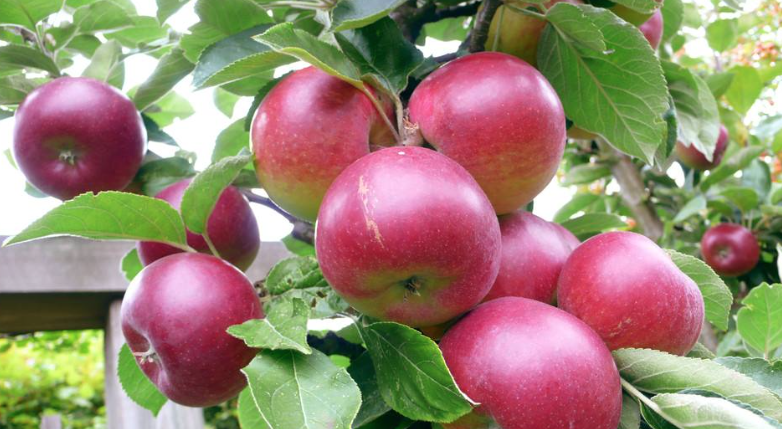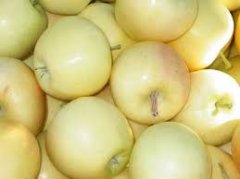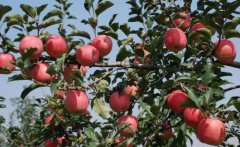One of the two-color apple varieties, babingo, how are the advantages and disadvantages of apple planting?
Babingo is one of the most important commercial apple varieties. It originated in New Zealand in the 1950s and was grown in all the major warm apple-growing areas in the world by the last decades of the 20th century. Braeburn accounts for 40 per cent of all apple production in New Zealand. Even in the conservative state of Washington, the most important apple producing area in the United States, Red Delicious and Golden Delicious have always been dominant, and babingo is now among the top five varieties.
The reason for success is not difficult to determine. Babingo has all the necessary standards for mass production: it is easy to grow, mass-produced early in the life of trees, well stored, and able to withstand the processing needs of the international supply chain. What stands out from the competition is the taste. Babingo is the first modern apple variety to be mass-produced, and its taste is similar to that of the old classic apple variety. The depth of the taste of babingo makes its main competition-red delicious and golden delicious-seems to be one-dimensional by comparison. At a time when consumers are looking for less boring things in their weekly shopping, Babingo is the right apple at the right time.
The commercial success of Babingo has opened the way for the development of many new apple varieties, among which flavor has become one of the main selection criteria. Babingo is one of the earliest "two-color" varieties and is now regarded as an essential feature of successful sales. By contrast, the first wave of supermarket apple varieties were either bright red (Red Delicious) or pure green (Golden Delicious and Granny Smith).
The combination of modern color and flavor means that Braeburn is actually the first of a new generation of modern apple varieties.
The first Beibin tree was discovered in New Zealand in the 1950s, named after Braeburn Orchards, where it was first planted commercially. It is usually thought of as a kind of seedling called Mrs. Hamilton. The parents of the other party are unknown, but it is widely believed to be Graney Smith-which is likely, given the time and place of his discovery, but there seems to be no scientific evidence to support this theory.
When the conditions are right, there is no doubt that Babingo is a first-class dessert apple. It is easy to surpass its late 20th century peer group (Golden Delicious,Granny Smith,Red Delicious), and they have a rich and complex flavor that they cannot match. In fact, Babingo is now the benchmark apple variety in many ways, and all other commercial varieties should rank it. It is brittle, not hard, and very juicy. It took a clean bite and immediately gave off a strong smell of apple. The overall flavor is refreshing, but the sweetness is well balanced-never sugar. Occasionally there will be some pear blossoms dripping into the flavor of the new season bagel (this feature is more prominent in its descendant jazz). Babingo is at its best when it is cooled to slightly below room temperature, and if you get a good one, it will really remind you why you like apples.
If there are shortcomings in Babingo, it may be due to poor quality control. Babingo is grown in warm apple-growing areas of the world and is well preserved. As a result, the quality and flavor of babingo apples may vary from different times of the year to consumers in different countries. Because Babingo is too old to be marked by a trademark, it is almost impossible to control the "brand"-in stark contrast to Pink Lady's strict control of production. Among producers in the southern hemisphere, we think that babingo from Chile tends to be very good-at its best in June. Babingo is also widely grown in Europe, and France seems to have the best climate for producing quality products-on trial in November.
Another weakness of Babingo is that while growth is not difficult, it is difficult to grow in an organic system-although the same is true of most competitors. Apple varieties have been developed for disease resistance, so they are more suitable for organic production, such as topaz-very similar to Babingo in many ways-has not yet achieved the same commercial success.
The storage of babingo is very good, and refrigerated apples are usually selected, but they are still slightly immature. Although some apples have improved in the store, babingo will be at its best soon after picking. Some growers and supermarkets from time to time provide high-quality mature trees with Braeburns, which is worth trying. They may have more red and less green than conventional stored apples.

- Prev

Aurora Apple, a new apple variety, is the nutrient of Aurora apple a hybrid variety?
Aurora apples are of medium size and have creamy to yellow skin. When growing in cooler areas, these apples can show pink or orange blush. The meat is very crisp, juicy and creamy to yellowish. Aurora apples are sweet, gentle, fresh and with
- Next

Introduction of New Zealand apple variety Qingfeng Apple, and planting conditions for the taste characteristics of Qingfeng apple
The breeze variety apple has some pink blushing apples on the yellow peel. It is fragrant and sweet, with very crisp, dense white meat. This is a refreshing and delicious snack for children and adults. Qingqing, currently grown by Freshco in New Zealand
Related
- A course of planting techniques and methods on how to grow carrots
- How to plant the latest tulips?
- Is it better to pick tea in the morning or in the afternoon? When is the best time for tea to be picked? what is the third or fifth tea?
- Launch Yuanxiao Happy combination Haocha + Tea Yuan healthy Taste
- Penghu Tourism "Fireworks 20 Parade with You"
- 2022 West Lake Happiness holds "Digital Revitalization Voucher" and draws iphone13 and laptop.
- Banqiao Fuzhou social houses are designed to change start-up combined with police elimination to create a safe and livable environment
- The convenient measure of "mechanical weeding" in Xinbei has been abused and the Agriculture Bureau has imposed heavy penalties on the illegal land consolidation.
- Changgeng University Joins Hands with Four Memory Factories to Rescue Memory Talent Shortage
- The list of Taiwan's top 100 MVP managers is listed by the Director-General of the Farmers' Association of Sanxia District.

